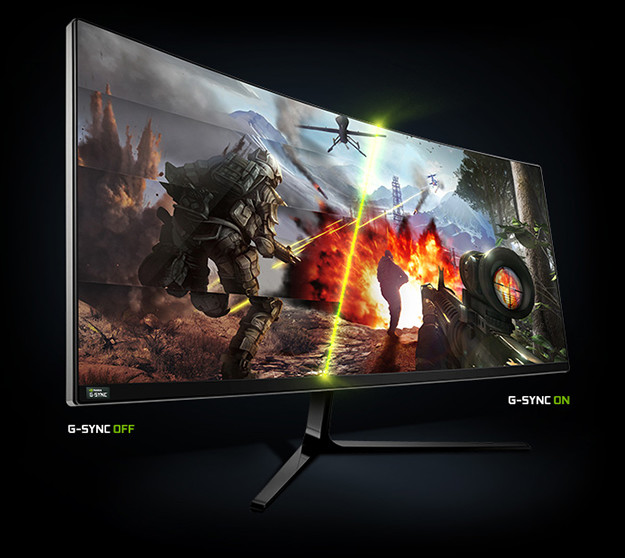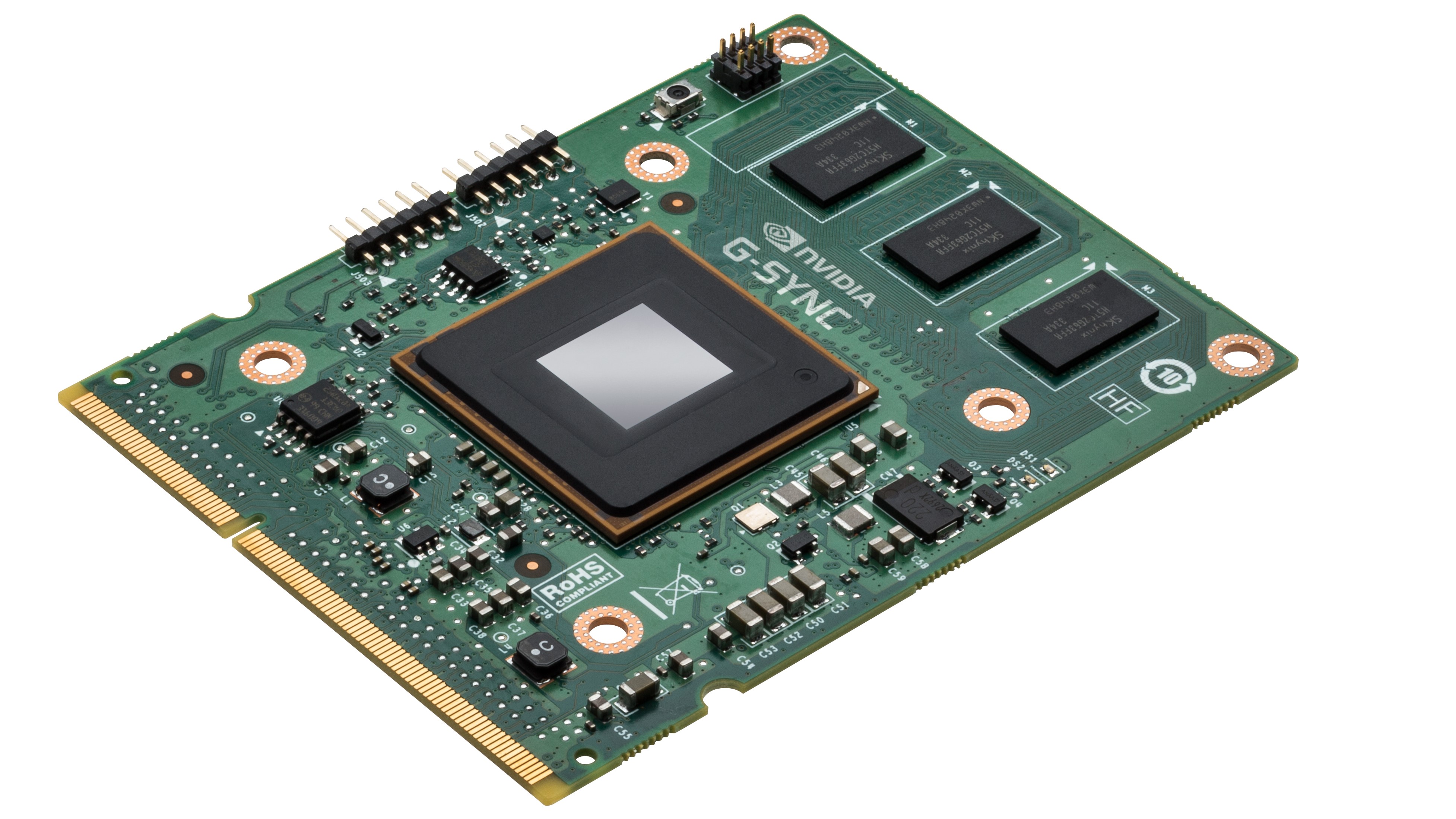What Is a G-Sync Monitor? Nvidia G-Sync Explained
Understanding what is Nvidia's G-Sync technology for preventing screen tearing.
You've come to the right place if you're wondering what is G-Sync. In short, Nvidia G-Sync is a type of display technology used in certain PC monitors, gaming laptops and TVs to fight screen tearing, stuttering and juddering, especially during fast-paced games or video. G-Sync only works when the display is connected to a system using a compatible Nvidia graphics card (including third-party branded ones). So if you don't yet have a compatible card, be sure to check out our graphics card buying guide, as well as our in-depth comparison of the features of AMD and Nvidia GPUs. And if you're after a portable G-Sync experience, check out our Gaming Laptop Buying Guide.
Nvidia introduced G-Sync in 2013, and its biggest rival is AMD FreeSync. But the answer to "what is G-Sync is getting increasingly complex. There are now three tiers of G-Sync: G-Sync, G-Sync Ultimate and G-Sync Compatible.
Screen tearing is an unwelcome effect on the image (see photo above). It’s the result of the game’s framerate (the rate at which image frames display) not matching the monitor’s refresh rate (the frequency at which a display’s image redraws). G-Sync displays have a variable refresh rate (also known as VRR or a dynamic refresh rate) and can sync its minimum and maximum refresh rates with the framerate of the system's Nvidia graphics card. That refresh rate range can go as high as the monitor's maximum refresh rate. This way, you see images right when they’re rendered, while also fighting input lag or delays between when you move your mouse (for recommendations, see our Best Gaming Mouse article) and when the cursor actually moves.
Check out Nvidia’s video below for an idea of what G-Sync looks like:
G-Sync vs. FreeSync
FreeSync is AMD’s answer to G-Sync, and both use VESA's Adaptive-Sync protocol. Just like you need an Nvidia graphics card to use G-Sync, you need an AMD graphics card to use FreeSync.
There are some key differences. One of the standouts is that FreeSync work over HDMI and DisplayPort, (which also works over USB Type-C), but G-Sync only works with DisplayPort, unless you're using a G-Sync Compatible TV (more on that below). However, Nvidia has said that it's working on changing this. For more on the two ports and which is best for gaming, see our DisplayPort vs. HDMI analysis.
In terms of performance, our testing has shown minute differences between the two. For an in-depth look at the variances in performance, check out our G-Sync vs. FreeSync article and see the results.
Get Tom's Hardware's best news and in-depth reviews, straight to your inbox.
While both G-Sync and FreeSync are based on Adaptive-Sync, G-Sync and G-Sync Ultimate also require usage of a proprietary Nvidia chip. Monitor vendors are required to buy this in place of the scaler they'd typically buy if they want their display certified for G-Sync or G-Sync Ultimate. FreeSync, on the other hand, is an open standard, and FreeSync monitors are generally cheaper than G-Sync or G-Sync Ultimate ones. However, G-Sync Compatible monitors don't require this chip and many FreeSync monitors are also G-Sync Compatible.
G-Sync vs. G-Sync Ultimate vs. G-Sync Compatible
G-Sync comes in three different flavors. G-Sync is the standard, G-Sync Ultimate targets those with HDR content and G-Sync Compatible is the lowest-priced form, since it doesn't require display makers to incorporate/buy Nvidia's hardware. Many G-Sync Compatible displays are also FreeSync-certified.
| G-Sync | G-Sync Ultimate | G-Sync Compatible |
|---|---|---|
| Validated for artifact-free performance | Validated for artifact-free performance | Validated for artifact-free performance |
| Certified with over 300 tests | Certified with over 300 tests | Row 1 - Cell 2 |
| Row 2 - Cell 0 | Certified for 1,000 nits brightness with HDR | Row 2 - Cell 2 |
Here you can find a list of every G-Sync, G-Sync Ultimate and G-Sync Compatible monitor.
G-Sync Ultimate
A monitor's G-Sync also works with HDR content, but things will look better if that monitor has G-Sync Ultimate, formerly called G-Sync HDR (for HDR recommendations, check out our article on how to pick the best HDR monitor).
Unlike regular G-Sync, Nvidia certifies G-Sync Ultimate displays for ultra-low latency, multi-zone backlights, DCI-P3 color gamut coverage, 1,000 nits max brightness with HDR video or games and to run at its highest refresh rate at its max resolution -- all thanks to "advanced" Nvidia G-Sync processors. Keep in mind these displays are typically BFGD (big format gaming displays) and, therefore, on the pricier end.
What You Need Run G-Sync or G-Sync Ultimate
To use a G-Sync monitor with a desktop gaming PC, you need:
- Windows 10, 8 or 7.1
- An GTX 650 Ti Boost graphics card or higher (for help picking a GPU, see our graphics card buying guide)
- DisplayPort 1.2 directly from the graphics card
- Driver R340.52 or higher
To use a G-Sync monitor with a laptop, you need:
- Windows 10, 8.1 or 7
- A GTX 980M, 970M, 965M or higher graphics card
- DisplayPort 1.2 directly from the graphics card
- Driver R340.52 or higher
To use a G-Sync Ultimate monitor with a desktop PC, you need:
- WIndows 10
- GTX 1050 or higher graphics card
- DisplayPort 1.4 directly from the graphics card
- Driver R396 GA2 or higher
To use a G-Sync Ultimate monitor with a laptop, you need:
- Windows 10
- GTX 1050 or higher graphics card
- DisplayPort 1.4 directly from the graphics card
- Driver R396 GA2 or higher
G-Sync Compatible
In 2019, Nvidia started testing and approving specific displays, including ones with other types of Adaptive-Sync technology, like FreeSync, to run G-Sync. These monitors are called G-Sync Compatible. Confirmed by our own testing, G-Sync Compatible displays can successfully run G-Sync with the proper driver and a few caveats even though they don't have the same chips as a G-Sync or G-Sync Ultimate display.
Some things Nvidia confirms you can't do with G-Sync Compatible displays compared to regular G-Sync displays are ultra low motion blur, overclocking and variable overdrive.
You can find the full list of G-Sync Compatible monitors at the bottom of Nvidia's webpage.
We've also found that numerous FreeSync monitors can run G-Sync Compatibility even though they're not certified to do so. To learn how to run G-Sync Compatibility, see our step-by-step instructions for how to run G-Sync on a FreeSync monitor, which includes details on the small number of limitations you'll face. And for what Nvidia and monitor makers think about running G-Sync on non-certified monitors, check out article Should You Care if Your Monitor Is Certified G-Sync Compatible?
G-Sync Compatible TVs
As of 2021, there are numerous LG-branded G-Sync Compatible OLED TVs. They work via connection over HDMI to a desktop or laptop with an Nvidia RTX or GTX 16-series graphics card. You also need to follow the instruction for downloading the proper firmware. Nvidia said it's working on getting more TVs that work with G-Sync Compatibility over HDMI in the future.
Here's every G-Sync Compatible TV announced as of this writing:
- LG 2021 B1 4K series (55, 65 or 77-inch)
- LG 2021 C1 4K series (48, 55, 65, 77 or 83-inch)
- LG 2021 G1 4K Series (55, 65 or 77-inch)
- LG 2021 Z1 8K Series (77 or 88-inch)
- LG 2020 BX (55, 65 or 77-inch)
- LG 2020 CX (487, 55, 65 or 77-inch)
- LG GX (55, 65 or 77-inch)
- LG 2020 ZX (77 or 88-inch)
- LG 2019 B9 (55, 65 or 77-inch)
- LG 2019 C9 (55, 65 or 77-inch)
- LG 2019 E9 (55 or 65-inch)
- LG 2019 Z9 (88-inch)
This article is part of the Tom's Hardware Glossary.
Further reading:

Scharon Harding has over a decade of experience reporting on technology with a special affinity for gaming peripherals (especially monitors), laptops, and virtual reality. Previously, she covered business technology, including hardware, software, cyber security, cloud, and other IT happenings, at Channelnomics, with bylines at CRN UK.



